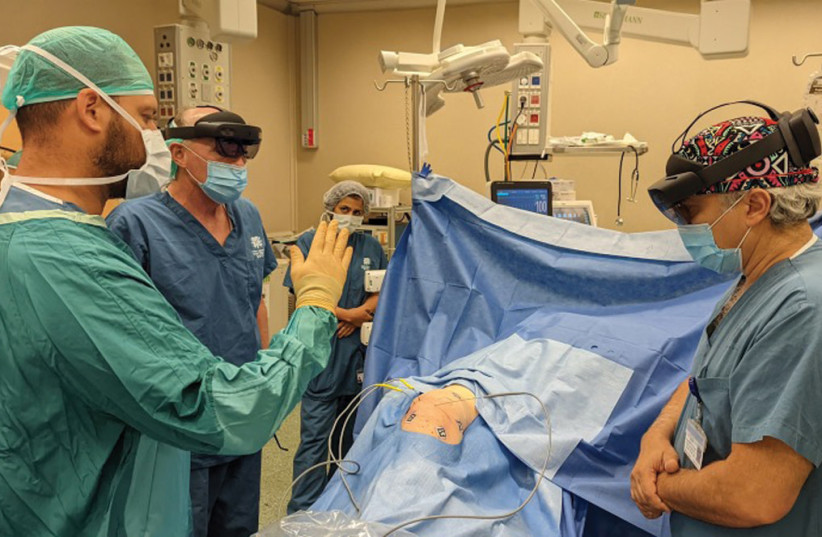A 25-year-old man was admitted to the emergency department of Jerusalem’s Shaare Zedek Medical Center (SZMC) after being seriously injured in a fall at his workplace. The trauma team diagnosed an unstable spine fracture that put the man at immediate risk for paralysis and other severe neurological damage.
After assessing the patient, Dr. Cezar Mizrahi, a neurosurgeon at the hospital’s spine surgery department, thought the patient could benefit from a new technological advancement: a robot-guided, augmented-reality-assisted imaging of the fractured spine.
The patient became the first in the world to undergo a procedure using augmented reality (AR) to repair an unstable spinal fracture. The operation involved AR-assistance guided by a surgical spine robot, allowing the team to apply surgical screws in an extremely precise fashion along the spinal column.
AR is an interactive experience that enhances the real world with computer-generated perceptual information. Using software, apps, and hardware such as special glasses, AR overlays digital content onto real-life environments and objects. This enriches the user experience and turns the immediate surroundings into an interactive learning environment that is revolutionizing the way companies manufacture, improve and distribute their products. It makes it possible for industrial users to “become one” with the systems and machines with which they work and to optimize and augment with human ingenuity, observation, and creativity.
AR works by superimposing digital information onto real-world objects to create a 3D experience that allows users to interact with both the physical and digital worlds, but it can’t and doesn’t exist alone. It is part of a cloud-connected Industry 4.0 (the numeral 4 stands for the Fourth Industrial Revolution) ecosystem that integrates everything from big data to automated robots.

How can augmented reality be used for surgery?
An AR-enabled device with a camera such as smart glasses, a tablet, or a smartphone parses a video feed to identify a physical object or the environment around the user, such as a piece of machinery or the layout of a warehouse. A 3D digital replica of the object in the cloud connects the real and virtual environments and collects information from the physical object and digital. The AR device then downloads information about the object from the cloud and superimposes digital information over the object using markers or trackers like GPS, accelerometers, orientation and barometric sensors, and more. This creates a part-real, part-digital 3D interface.
“Bringing together AR and robotics in this minimally invasive technique had never been performed in surgery anywhere in the world,” said Mizrahi after the successful operation. “To our great joy, this combination of those new innovations was to the direct benefit of this patient and the overall healthcare improvement for the people of Jerusalem and beyond.
The experience of performing surgery equipped with an AR headset felt like being a combat pilot,” he recalled. “I had all the patient’s vital information, including the CT images, displayed directly in front of me. I could look one way and see the lineup of the surgical screws that I had planned out before the procedure and then look down and see the surgical field magnified. The experience helped me perform the procedure exactly as I planned it, and only make adjustments that I might have felt necessary as the surgery developed.”
Dr. Nevo Margalit, head of SZMC’s neurosurgery unit, added, “We view the chance to embrace all technological advancements for the benefit of our patients with the utmost importance. We are committed to be on the forefront of introducing new and future technologies for the betterment of medicine here in Israel and around the world.”
Dr. Yair Barzilai, director of the spine surgery unit, commented that “our unit is acting as a technological pioneer that results from a close partnership with the digital healthcare industry. We were very glad to see the excellent results after this surgery performed by Dr. Mizrahi, where he was able to address an unstable fracture that without successful intervention could have seen the patient suffering from severe neurological damage.”
The patient said he felt well and could walk without any assistance immediately after the surgery and is expected to be released from the hospital in the coming days. He thanked the hospital staff, saying that “We are so thankful for Dr. Mizrahi’s treatment. Before the surgery, we were very worried and didn’t know what would be, but it was performed quickly and successfully, and I’ve recovered faster than expected. Dr. Mizrahi regularly comes to check on me and from the bottom of my heart, I’m just so grateful.”
